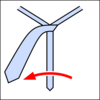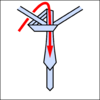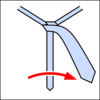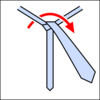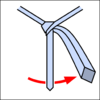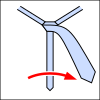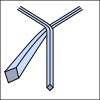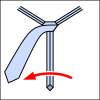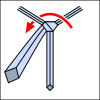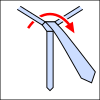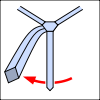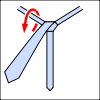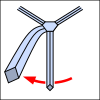Tie knot
With the tie knot , the loop of the tie is created, which ensures the mechanical hold on the neck. The tie knot can be divided into the standard knot, like the Windsor or the Pratt knot, and the special forms, like the Onassis knot, the inverted knot or the square knot.
In some embodiments, is located below the node a small groove or fold, in the technical jargon "dimple" (eng. For dimples , depression ) called. There are opponents and supporters for this particular expression. It is up to the taste and preference of the wearer of the tie whether or not a tie crease contributes to the good looks.
Standard node
|
|
|
|||
|---|---|---|---|---|
 Seam points towards the neck Seam points towards the neck
|
small big |
Half Windsor Knot (*) Windsor Knot * |
small big |
Four-in-hand * Victoria * Cavendish (*) |
 Seam points outwards Seam points outwards
|
small big |
Pratt (Nicky *) Andreas * Balthus *; Hanoverian (*) |
small big |
Little Knot Kelvin Plattsburgh (*) Grantchester * |
|
* The knot is self-releasing, meaning that it will disintegrate completely when the narrow end is pulled up out of the knot. (This is exactly the case if the knot ends with (*) There is a self-releasing variant of the knot |
||||
Standard knots are knots in which the wide end of the tie is looped around the narrow end without torsion . This creates an adjustable loop and the narrow end can be pulled back and forth through the knot.
The mathematicians Thomas Fink and Yong Mao have systematically examined all tie knots that can be tied in this way and described a total of 85 knot variants for ties of normal length. The majority of these knot variants, however, result in knots that are misshapen or difficult to tighten. This means that the number of nodes that can be used in practice is manageable and only contains a few variants of a node class (see section Systematic classification of standard nodes ).
The four classics
The pictures on the right are reversed, like your own mirror image.
Four-in-hand
Also known as a simple knot .
The origin of the name four-in-hand (“four in hand”) has not been clearly established. One theory is that coachmen tied this knot on their reins. Others believe that the members of the London Four-in-Hand Club made this tie knot socially acceptable.
Half Windsor knot
Often wrongly called "simple Windsor knot".
It is not known whether the half Windsor knot emerged from the Windsor knot or was created independently. Occasionally this knot is also referred to as a half English or Turkish knot.
- Self-releasing variant
A bit more asymmetrical than the other variant.
Windsor knot
Also often called "double Windsor knot".
The name can be traced back to the Duke of Windsor , who did not invent this knot himself. In his book A Family Album (Cassell, London, 1960) he writes that the knot invented in the United States was mistakenly named after him because he always wore thick tie knots. However, these were caused by the thick cloth of his ties and not by a particularly complex knot. Sometimes there is also the term English knot .
- Variant with two ring movements
This variant with two ring movements leads to a slightly narrower, but still full knot. It fits most ties and is therefore very popular.
- Variant: Persian knot
The Persian knot is a Windsor knot with a ring and diagonal movement. This creates a knot that is not self-releasing.
Pratt knot
The Pratt knot was invented by US Chamber of Commerce member Jerry Pratt . Occasionally the knot is also referred to as the Shelby knot : after Pratt taught TV presenter Donald Shelby its knot, he often wore it on his shows.
- Self-releasing variant ("Nicky")
This variant has a slightly higher dimensional stability.
Further
Saint Andrew's knot
Balthus knot
Hanoverian knot
Named after the Hanoverians
The Hanoverian knot is an extension of the Windsork knot.
- Self-releasing variant
Victoria knot
- Variant: Prince Albert Knot
In the last step of the Victoria knot, the broad end is passed under both horizontal strips. The result is a knot that is reminiscent of a calyx, similar to a square knot .
Cavendish knot
The Cavendish knot is created by executing two four-in-hand knots one behind the other .
- Self-releasing variant
Small knot
Also known as an oriental knot .
This node is the final component of all standard nodes. It is very popular in China. To achieve a sizable knot, you need a tie made of thick cloth.
Kelvin knot
Named after Lord Kelvin .
As with the Victoria knot , a variant is also possible here: in the last step, the wide end can be pushed through under both horizontal strips. The Kelvin knot is the smallest knot where this is possible.
Plattsburgh knot
Named after the city of Plattsburgh in the USA .
- Self-releasing variant
Grantchester knot
Named after the town of Grantchester near Cambridge .
In Germany, however, the designation Manhattan node is also common.
Systematic classification of the standard nodes
| Starting position |

|

|

|

|
|
| horizontal movement |

|

|

|

|
|
| Center movement | Diagonal movement |

|

|

|

|
| Ring movement |

|

|

|

|
|
| Conclusion (= small knot ) |
- | - |
 
|
 
|
|
While a tie knot is being tied, the narrow end of the tie always remains in the same position and the wide end is moved. These patterns occur:
- The wide end is to the left of the narrow end
- The wide end is to the right of the narrow end
- The wide end is in the loop
The last state can also be interpreted as a transition between the first two. If you only consider the movements that move the wide end from one side of the narrow end to the other side, you will find that exactly three movements are possible in every situation:
- horizontally over the narrow end (or through it)
- through the noose to the other side
- through the loop back to the starting position
The possible movements for all starting positions are listed in the adjacent table. Since the small knot is formed at the end of each standard knot, it is sufficient for a complete description of a knot to list the movements up to the little knot. Half the Windsor knot, for example, results from the sequence of movements
- horizontal - diagonal (+ small knot) ,
the Windsor knot
- diagonal - horizontal - diagonal (+ small knot)
Nodes with the same number of center and horizontal movements are similar in shape and size. It is therefore advisable to classify the standard nodes according to these quantities. Nodes of the same class only differ in the order of the movements and in the type of center movements (diagonal or ring movement). We define the size of a node as follows:
- the small knot is size 3
- a horizontal movement increases the size by 1
- a center movement increases the size by 2
Trying it out shows that normal ties are too short for knots of size 10 and more. The following diagram classifies the nodes up to size 9, where stands for the number of center movements and for the size. A horizontal line symbolizes a horizontal movement, a diagonal line a central movement. Since these are divided into diagonal and ring movements, the diagonal lines appear in pairs.
A simple consideration shows that the size of the knots (marked in blue in the diagram), where the seam points to the neck, is always even, and that, on the other hand, the size of the knots with the seam facing outwards is always odd.
Conversely, the orientation of the seam can be derived from the parity of the size of a node. However, it is also possible to tie an odd-sized knot with the seam facing inwards (and vice versa). To do this, just twist the wide end before binding.
In practice, the nodes marked with an X turn out to be unaesthetic, so that 13 classes of usable nodes remain. A class includes all nodes that consist of the same number of center movements and horizontal movements (without the small node at the end). The number of sequences of these movements is , in addition, there is an independent ring or diagonal movement for each of the central movements . The number of nodes in a class is therefore .
The following table results:
| Class number |
Number of nodes in the class |
Names of the nodes | horizontal movements |
Center movements |
size |
|---|---|---|---|---|---|
| 1 | 1 | Small knot | 0 | 0 | 3 |
| 2 | 1 | Four-in-hand | 1 | 0 | 4th |
| 3 | 1 | Kelvin | 2 | 0 | 5 |
| 4th | 1 | Victoria | 3 | 0 | 6th |
| X | each 1 | (no nice looking knots) | 4, 5, 6 | 0 | 7, 8, 9 |
| 5 | 2 | Nicky , Pratt | 0 | 1 | 5 |
| 6th | 4th | Half Windsor + 3 variants | 1 | 1 | 6th |
| 7th | 6th | Sankt Andreas + 5 variants | 2 | 1 | 7th |
| 8th | 8th | Cavendish + 7 variants | 3 | 1 | 8th |
| 9 | 10 | Grantchester + 9 variants | 4th | 1 | 9 |
| 10 | 4th | Plattsburgh + 3 variants | 0 | 2 | 7th |
| 11 | 12 | Windsor + 11 variants | 1 | 2 | 8th |
| 12 | 24 | Hanoverian + 23 variants | 2 | 2 | 9 |
| 13 | 8th | Balthus + 7 variants | 0 | 3 | 9 |
| total | 85 | ||||
Special node
Onassis knot
The Onassis knot was worn by the Greek shipowner Aristotle Onassis .
The basis of the Onassis knot is the four-in-hand or another small knot, over which the broad end is thrown.
Square knot
Christensen knot
This variant of the Cavendish is only suitable for narrow ties.
In the last step, the wider end is passed under both horizontal strips so that two intersecting strips remain visible on the knot.
Inverted nodes
In default node with an odd size, the seam of the narrow end facing away from the body. If you look at the finished tie from the back, this seam is not visible. This leads to the idea of using the back of the standard knot as a new knot: Every odd-sized standard knot results in a new knot by swapping the two ends when tying the knot from the beginning, i.e. looping the narrow end around the wide end, and the finished tie is rotated 180 °. It is advisable to tie the tie in hand and only then put it on.
Inverted nodes are smaller than the corresponding standard nodes because the narrow end contributes less material to the volume build-up. The required length of the tie is roughly the same.
A selection of inverted nodes:
Atlantic knot
This is an inverted Pratt node .
Diagonal right knot
This is an inverted Kelvin knot .
The name comes from the diagonal small loop on the right side - as seen from the wearer.
Merovingian knot
This knot was named after the Merovingian Matrix figure and is originally also known as Ediety .
The knot is an inverted knot with the sequence of movements
- Ring - horizontal - ring - horizontal - ring (+ small knot)
and is therefore size 11. An extra-long tie is essential for the Merovingian knot.
gallery
See also
- Tying a bow tie (bow tie) .
literature
- Thomas Fink, Yong Mao: The 85 Ways to Tie a Tie. Piper, Munich 2006. ISBN 3-492-24739-3
- Thomas Fink, Yong Mao: Tie knots, random walks and topology (PDF; 197 kB). in: Physica A 276. Amsterdam 2000, 109-121. ISSN 0378-4371
Individual evidence
- ↑ Thomas Fink, Yong Mao: Tie knots, random walks and topology (PDF; 197 kB). in: Physica A 276. Amsterdam 2000, 109-121. ISSN 0378-4371
- ↑ The Kent knot. Spotn.de, October 19, 2007, archived from the original on September 11, 2010 ; accessed on August 24, 2014 .
Web links
- Encyclopedia of Tie Knots by Thomas Fink
- Krawattenknoten.org with instructions for various tie knots, tie care and dress codes
- Detailed instructions for various knots as pdf (English) - page by Lord Whimsy
- Summary of 20 different tie knots with associated learning videos
- More knots
- Alex Krasny: Eldredge. In: YouTube . Retrieved April 6, 2013 .
- Alex Krasny: Trinity. In: YouTube. Retrieved April 6, 2013 .
- Alex Krasny: Cape. In: YouTube. Retrieved April 6, 2013 .
- Patrick Novotny: Novotny. In: YouTube. Retrieved April 6, 2013 .
- Eliot Truelove: Truelove. In: YouTube. Retrieved April 6, 2013 .
- Eliot Truelove: Ellie. In: YouTube. Retrieved April 6, 2013 .
- Sidewinder. In: YouTube. Retrieved April 6, 2013 .
- Fancy braided. In: YouTube. Retrieved April 6, 2013 .
- The Left Ostridge. In: YouTube. Retrieved April 6, 2013 .


